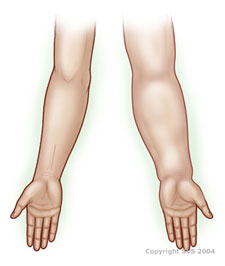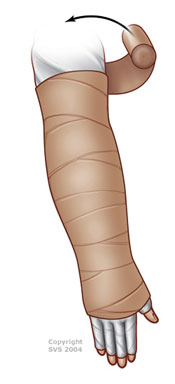Mesentric Ischemia
What is lymphedema?
Lymphedema occurs when a clear fluid known as lymphatic fluid builds up in the soft tissues of your body, usually in an arm or leg. The lymphatic system consists of lymph vessels and lymph nodes that run through your body. Lymph vessels collect a fluid that is made up of protein, water, fats, and wastes from the cells of the body. Lymph vessels carry this fluid to your lymph nodes. Lymph nodes filter waste materials and foreign products, and then return the fluid to your blood. If your vessels or nodes become damaged or are missing, the lymph fluid cannot move freely through the system. The fluids can then build up and cause swelling, known as lymphedema, in the affected arms or legs.
There are two types of lymphedema:
- Inherited lymphedema, sometimes called primary lymphedema, in which you are born lacking lymph vessels and nodes. The swelling usually appears during your adolescence and affects your foot or calf. A rare form of primary lymphedema develops in infancy and is called Milroy’s disease
- Acquired lymphedema, sometimes called secondary lymphedema, in which an injury to your lymphatic system causes lymphedema. It is much more common than primary lymphedema

Some people develop chronic lymphedema, which can last for the rest of their lives. Chronic lymphedema can be difficult to treat. Swollen limbs may become vulnerable to infection. Even a minor injury to the skin, such as a cut, scratch, insect bite, or even athlete’s foot between the toes can cause a severe infection, which physicians call lymphangitis. Lymphangitis affects the connective tissue under the skin. Repeated infections can cause scarring that makes the tissue vulnerable to more swelling and infection. This leads to the tissue hardening, called fibrosis, which is characteristic of advanced chronic lymphedema.
What are the symptoms?
If you have lymphedema, you may not develop symptoms immediately. Sometimes symptoms occur 15 or more years following an injury to your lymphatic system. When symptoms eventually occur, they can include:
- Aching, weakness, redness, heaviness, or tightness in one of your limbs
- Less flexibility in your wrist or ankle
- Tight-fitting rings or shoes
What causes lymphedema?
The most common causes of secondary lymphedema are surgery or radiation treatment for certain types of cancer, such as breast and testicular cancers. Other causes of lymphedema include surgery on the blood vessels in your limbs or other surgical procedures, like liposuction, as well as burns.
What tests will I need?
First your physician asks you questions about your general health, medical history, and symptoms. In addition, your physician conducts a physical exam. Together these are known as a patient history and exam. Your physician may also measure your affected limbs.
To confirm a diagnosis of lymphedema, your physician may order tests, including one or more of the following:
- Lymphoscintigraphy, which uses a low-dose injected radioactive substance to trace the flow of lymph fluid through your lymphatic vessels;
Magnetic resonance imaging (MRI), which uses radiowaves and magnetic fields to detect patterns in your internal tissues that are characteristic of lymphedema - Computed tomography (CT) scanning, which creates images of your internal tissues from a series of cross-sectional x-rays
- Duplex ultrasound, which uses high-frequency sound waves and Doppler technology to show vessels and real-time blood flow on a screen, often necessary to rule out a blood clot in your leg
- Lymphangiography, which uses contrast (dye) directly injected into the lymphatic vessels, is now used less frequently
How is lymphedema treated?

If you are at risk for developing lymphedema, you can act to prevent it. Initially, if you have mild lymphedema, you can act to keep the condition from worsening. You can take the following precautions to prevent or minimize symptoms:
- Clean your affected limb regularly. Remember to dry it thoroughly and apply lotion
- Wear gloves while gardening and cooking
- If you shave the affected area, use an electric razor
- Don't go barefoot
- Do not cross your legs when you sit
- Do not carry a handbag with your affected arm
In addition, if you are at risk for lymphedema, avoid having injections and blood pressure readings performed on your affected limb. You can also wear a special bracelet or necklace to notify medical personnel of your risk for lymphedema and the risk for complications, such as infection.
Physicians have not agreed about how to best treat chronic lymphedema. Some people have benefited from manual lymphatic drainage. This treatment uses massage to stimulate your weakened lymphatic system. Other treatment methods include special exercises that you can do while wearing compression stockings or bandages, and the use of external pumps to aid the movement of fluid through your body. A treatment that combines these treatments with lifestyle changes is called complex decongestive therapy.
Medication cannot cure lymphedema. However, your physician may prescribe medications to treat associated conditions. For example, antibiotics play an important role in combating infections that can worsen lymphedema.
Your physician may recommend surgery to remove excess tissue if your limb becomes so large and heavy that it interferes with your ability to move it.
Treating your lymphedema requires your participation. Because lymphedema can be very painful, you may benefit from individual counseling. You can also join support groups that provide practical advice as well as social and emotional support.

